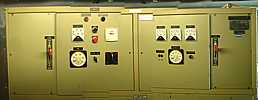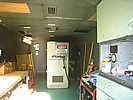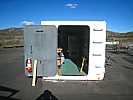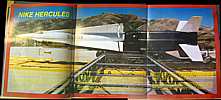History of Nike SF-88 Restoration,
- just starting -
This web page was started September 2015,
almost 20 years after most restoration completed.
Table of Contents
-
Initial planning meeting via Greg Brown. November 2023
- National Historic Landmark ??
- Missing History
- Traces, clues
- Individual Stories - alphabetical order -
- Alec Gyorfi
- Bud Halsey (National Park Service web page)
- "Bud" Halsey, obituary
- Al Kellogg - some SF-88 restoration history
- Dave Kreutzinger
- Ezio Nurisio
- Ron Parshall
- Ed Thelen
- An e-mail to try to get a Restoration History Going
- A 1996 magazine article appearing in "High Power Rocketry"
National Historic Landmark ??
Greg Brown to Ron Jacobs, Oct 12, 2022
|
Ron,
I just asked this question to our NPS Supervisory Curator last week. I found the original application for Historic Status for SF-88 Launcher and IFC, on the NPS GGNRA website. Dated Dec 12 1973. SF-88 seems to be “ part of ” under the heading of Fts, Baker, Barry & Cronkite Historic District. Our NPS Supervisory Curator seemed to think this was the case. My question is, Is SF-88 a "stand alone" historic site? it may, or may not have those protections, being part of the Historic District. If the vans and missiles were to disappear, and it still could be a historic site, as a plot of ground, and the standing structures, much like theSF-88 IFC area is at Wolf Ridge. Not sure how to interpret this? Any Ideas? Greg Brown |
|
There is an excellent book
"The Last Missile Site - An Operational and Physical History of Nike Site SF-88
Fort Barry, California". Highly Recommended - and a real bargain !!
(A rumor suggests that a co-author, John A Martini, was the site SF-88 manager even before Bud Halsey.) However, this book does not cover the restoration (heavy duty maintenance ;-) nor current maintenance of Site SF-88. The restoration was organized and led by Bud Halsey, obituary, local copy a retired Infantry Colonel. Bud was a large, imposing, determined, persistent, "horse-trading" individual who spent his abundant energy and probably not so abundant retirement money on the restoration of SF-88. At some time, the National Park Service appointed/hired him to be manager of the site. Bud attracted about a dozen Nike veterans with various skills into the restoration effort. The story of the restoration of SF-88 from 198? through 1995 will have to be told by others. I (Ed Thelen) blundered into SF-88 in about 1995 when it was almost at its current state of restoration. The last remaining major problem was inability to erect a missile to launch position. This was soon solved by eliminating the voltage droop to the launcher due to long cables. The restoration of SF-88 by Bud Halsey and his crew of volunteers was largely complete in 1996. Unfortunately, the Internet, and private web pages were just getting popular at this time. The items of progress and pictures of the restoration are largely in the heads of some getting older, old men.
In 2001, Bud Halsey died, and there was some turbulence not discussed here.
|
|
1000 hour plaques in
Marin Headlands Visitor's Center |
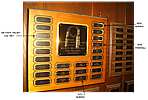
|
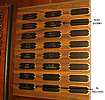
|
National Park Service page on Bud Halsey
local copy of http://www.nps.gov/partnerships/halsey.htm
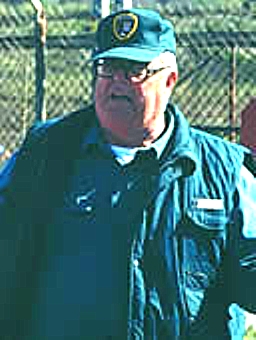 The Fort Barry Nike Missile Site SF-88 Volunteers is a community-based partnership whose members served at Nike missile
air defense sites during the Cold War era. The group formed specifically to restore the historic Nike Site SF-88L, at
Fort Barry in the Marin Headlands of Golden Gate National Recreation Area. The Nike Missile Site SF-88 Volunteers
restored the abandoned and derelict site into the most complete Nike Missile site today in the United States.
The Fort Barry Nike Missile Site SF-88 Volunteers is a community-based partnership whose members served at Nike missile
air defense sites during the Cold War era. The group formed specifically to restore the historic Nike Site SF-88L, at
Fort Barry in the Marin Headlands of Golden Gate National Recreation Area. The Nike Missile Site SF-88 Volunteers
restored the abandoned and derelict site into the most complete Nike Missile site today in the United States.
The "sparkplug" for the success of the preservation effort was the late Col. Milton F. "Bud" Halsey, U.S Army (ret.). A 6'6" energetic mountain of a man, Bud used skills honed during a thirty-year Army career to track down the remaining Nike Missile site equipment and resources needed to haul 18 trailer loads to Fort Barry from around the country to put the Nike Missile site back together. His vision and leadership helped recruit and organize the volunteer Nike veterans and encouraged the National Park Service to take an interest in fully restoring the site. Brian O'Neill, Superintendent of Golden Gate National Recreation Area, comments on Col. Bud Halsey: Bud Halsey was a leader who inspired others to his vision. He applied the same mission focus he had as a colonel in the U.S. Army to lead a tremendous volunteer effort that restored one of the most important historic resources in the country. Stephen Haller, Historian at Golden Gate National Recreation Area, comments on Bud Halsey: Bud was the visionary for the restoration of the Nike Missile site in the Marin Headlands and for the volunteers that worked there. He used the experience and contacts gained from his rank as colonel and years in the Army to obtain technical assistance, spare parts, and missile equipment that would ordinarily have been unavailable to the National Park Service. His networking and leadership formed the core around which numerous Nike veterans rallied to perform many thousands of hours of skilled and unskilled labor to restore the site. Bud participated in the Nike Missile site project because he felt driven to protect the nation's military heritage. He received satisfaction in taking on a leadership role that allowed him to control an operation much like he was used to in the military. Bud was a leader. When he said "jump," you said "how high sir?" He also had an unparalled knowledge of Army procedures that paid off handsomely at the Nike Missile site. |
Local copy of obituary for "Bud" Halsey
Local copy of obituary for "Bud" Halseyfromhttp://www.sfgate.com/news/article/HALSEY-Colonel-Milton-Baldridge-Jr-2967050.php Published 4:00 am, Tuesday, January 9, 2001 no picture was included 
"lifted" from http://www.nps.gov/partnerships/halsey.htm a National Park Service web page
HALSEY, Colonel Milton Baldridge, Jr. -- Better known as 'Bud'. Career, army officer, local historian, public speaker known for his stentorian tones, large stature and gentle demeanor, passed on January 4, 2001 in Marin County. He was a walking encyclopedia on western Military history, US Civil War, General Custer, Indian Wars, the Presidio, coastal defense and Nike missile defense systems. He was born at Ft. Leavenworth, Kansas in 1933. He spent his childhood at numerous Army posts in the United States and overseas accompanying his father -- a Regular Army officer. In 1955, he graduated from the Citadel, the Military College of South Carolina, with honors, and received a degree in Political Science. As a Distinguished Military Graduate, he was commissioned a second lieutenant of infantry in the Regular Army. Bud served in a variety of infantry assignments in the 2d, 3d, and 5th Infantry Divisions, both in the United States and overseas. He is a graduate of the Infantry School, the Armor School, and the Command and General Staff College. He served in combat in both Korea and Vietnam as the Conmmander of the 2d Battalion, 38th US Infantry and as Senior Advisor to the 43d Vietnamese Ranger Battalion. In addition to service as an instructor at the Army's Command and General Staff College, he served on the staff of the Secretary of Defense and with the State Department. He also served in Germany and Panama; and as the deputy commander, 93rd Infantry Brigade; as Senior Army Advisor to the 91st Division; and with Headquarters, Sixth US Army. On August 1, 1985, he retired from the Army after completing over 30 years of service and rising to the rank of Colonel. His military awards include the Silver Star Medal, Legion of Merit (2 awards), Bronze Star Medal, Meritorious Service Medal (2 awards), Joint Services Commendation Medal, Army Commendation Medal (2 awards), the Vietnamese Cross of Gallantry with Palm, the Vietnamese Cross of Gallantry with Silver Star, Vietnamese Ranger Badge, Parachutist Badge and Combat Infantryman's Badge. Following his military career, he became the Executive Director of the Fort Point and Presidio Historical Association. He was the driving force behind the refurbishiing and opening as an historic site the Nike missile site in the Marin Headlands of the Golden Gate National Recreation Area of the National Park Service. Within the last decade, Bud devotedly served thousands of hours as the full time volunteer site manager. He authored numerous published articles on western military history, lectured, taught, gave tours, shared his vast store of knowledge and historical archives unstintingly and graciously with all who requested them. He was a member of various historical associations including charter membership in the Council on America's Military Past and had, at one time, served as its National Second Vice President and also served on its board of directors. He served most recently as the historian for the Fort Point and Presidio Historical Association. Bud was a self-effacing kind, generous, taciturn, highly-principled individual. He was a joy to be around, had a dry wit and a delightful sense of humor. He was a gentleman and a scholar. His wife of 43 years, Sandy; and their children Laurie, Tom, Jon and Meg remember him with warmth and love and plan to pass on to Bud's seven grandchildren his values and sterling qualities. Interment will be at Arlington National Cemetery. Your remembrance of him and his fine qualities will be his memorial. No service will be held at his request. Memorial contributions may be made to the Christian Science Church, P.0, Box 517, Mill Valley, CA, 94942. 435-764-5009 |
Al Kellogg - some SF-88 restoration history - photo by Greg Brown
 October 7, 2017
October 7, 2017
While a group of us were wondering about how SF-88 got restored, Dave Kreutzinger mentioned that Jacques Littlefield donated about $600,000 dollars to help the restoration and transportation effort. Apparently about 20 truck loads of launchers, launcher racks, missiles, missile control vans, the Battery Control van, the Radar Control van, various antennas, spare parts, ?manuals?, ... were secured from various U.S. Army depots. |
 I arrived late in the restoration, but got to go on a last trip to get material - to China Lake, California.
Bud Halsey made the contacts and got the OKs.
Others of us took several autos, a pick-up truck or two, and a flat bed trailer for a spare Acquisition Antenna
(among other things) we wanted to get. We paid our own way, gas, motels and all.
I arrived late in the restoration, but got to go on a last trip to get material - to China Lake, California.
Bud Halsey made the contacts and got the OKs.
Others of us took several autos, a pick-up truck or two, and a flat bed trailer for a spare Acquisition Antenna
(among other things) we wanted to get. We paid our own way, gas, motels and all.
We hear tales from other sites "We don't have a budget to ship ...", just do the paper work and get it !!
I also did an unusual project for Bud Halsey. Simulate a Nike Hercules engagement using some of the equipment in the BC Van, a PC, and some special I/O cards. Bud gave me a spare chassis used to hold the CRT to display the Acquisition Radar information. The CRT had already been removed, and I replaced it with a display from an IBM PC that displayed only orange (the color of the original display). It was a good job :-)) a casual person could not tell that a different CRT was in the installed chassis when working. I made a simulation program similar to this, which can be played on your Windows PC or Mac browser . Collecting information from the Target Designate handwheel (instead of a mouse) and the Missile Launch switch, the simulation showed the Target Designation by the operator, show the TTR tracking cross on the simulated target, and show a simulated missile interception. The simulation could also drive the Target Speed Indicator. I donated the PC, Bud paid for the IBM Monitor (used) and the special I/O cards. This equipment was removed from the BC Van in about 2002 - |
An e-mail to try to get a Restoration History Going
Subject: Oct 3, picnic, make web page of SF-88 restorers
From: < ed@ed-thelen.org >
Date: Sat, Sep 19, 2015 4:25 am
To: almerx@sbcglobal.net, webmaster@nikemissile.org, historian@nikemissile.org
Cc: "Greg Brown" < gregorio_cafe@comcast.net >, "Gordon Lunn" < gordonlunn@aol.com >,
"Ron Parshall" < NikeMSL@juno.com >, dkreutzinger@earthlink.net,
"Jerry Freight" < freightject@sfmail.net >, "Al Blank" < Al_Blank@nps.gov >
I would like to make a web page/section,
which lists/shows
the volunteers that restored the SF-88 Nike Site
and to start
a history of that restoration.
[...]
Many/most of the original restorers seem to belong to the
Nike Historical Society
which is holding a picnic at SF-88 - Oct 3rd
This would seem to be a great time to get individual/group photos
and contact info
and start collecting stories and time-lines of the SF-88 restoration.
This story is totally unknown to the current NPS people,
and many of the current docents.
I am a "Johnnie come lately", arriving in 1996, when the work
was almost completed to its present state,
and don't even know when Bud Halsey started organizing the restoration.
( The last remaining thing (in 1996) was to
get proper power to the elevator launcher
so that it would actually raise a missile,
without chattering relays and tripping circuit breakers.
And since I'm an IFC guy, I'm clueless about that. )
Questions
a) a good idea for my web site?
or should it be organized and posted by Nike Historical Society
and/or both ??
b) Time Line of the restoration ??
c) lots of newsy details ;-))
- negotiations and trips to get vans, missiles, needed parts, ...
- gads, and the launchers, racks, cables, ...
- struggles against water, rust, crudded up parts, ...
- pictures of before, during, after ...
- a list of accomplishments, tubes lit up, acq antenna gear replaced, ...
- concrete pads for IFC equipment ....
- the restoration was a major, unequaled success !!
- heck - even the toilets, phone, power, running water, ...
- and the 400 Hz converters, and ...
- and on and on and on ...
d) probably totally ignore intermediate turmoil
Really, this is a great, untold, interesting story !!!
Thanks for your consideration and comments
-Ed Thelen
PS Alec Gyorfi does not do e-mail -
|
1996 magazine article appearing in "High Power Rocketry" - A .pdf version
Published (I think) by National Association of Rocketry (NAR) (Jack Hagerty, below, says this magazine is defunct, replaced by an on-line magazine.) NAR - (800) 262-4872, 319-373-8910 P.O. Box 407, Marion, IA 52302 http://www.nar.org/ Local club Livermore Unit of the NAR (LUNAR) #534 Contact: Jack Hagerty 785 Jefferson Ave Livermore, CA 94550 (925) 437-8543 - JHagerty@juno.com
|


